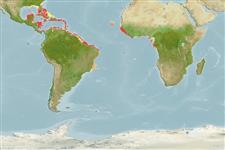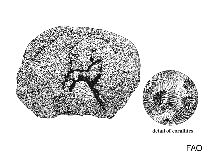Favia fragum (Esper, 1793)
Golfball coral| Native range | All suitable habitat | Point map | Year 2050 |

|
| This map was computer-generated and has not yet been reviewed. |
| Favia fragum AquaMaps Data sources: GBIF OBIS |
Upload your photos
Google image | No image available for this species;
drawing shows typical species in Faviidae.
Google image | No image available for this species;
drawing shows typical species in Faviidae.
Classification / Names Common names | Synonyms | CoL | ITIS | WoRMS
Anthozoa | Scleractinia | Faviidae
Environment: milieu / climate zone / depth range / distribution range Ecology
Reef-associated; depth range 0 - 30 m (Ref. 848). Subtropical; 33°N - 25°S, 92°W - 12°E (Ref. 848)
Distribution Countries | FAO areas | Ecosystems | Occurrences | Introductions
Atlantic Ocean.
Length at first maturity / Size / Weight / Age
Maturity: Lm ? range ? - ? cm Max length : 5.0 cm COLD male/unsexed; (Ref. )
Short description Morphology
Colony: small, usually less than 50 mm across, hemispherical to encrusting. Corallites: shape range from immersed to conical to tubular, may be circular with one mouth, to elongate with multiple mouths; intertidal encrusting colonies may be submeandroid; spherical colonies with unrestricted growing space often with tubular corallites; valleys seldom more than 5 mm across; walls neatly rounded, whatever the corallite shape. Septo-costae exsert and evenly spaced. Color: often tan to light orange-brown with pale green tentacles (Ref. 848).
Zooxanthellate (Ref. 116012). Common in shallow less than 15 m; reef habitats and sometimes seagrass beds (Ref. 415). Also in intertidal rock pools and shallow reef environments (Ref. 848).
Life cycle and mating behavior Maturity | Reproduction | Spawning | Eggs | Fecundity | Larvae
Hermaphroditic (Ref. 113712). Mature gametes are shed into the coelenteron and spawned through the mouth. Life cycle: The zygote develops into a planktonic planula larva. Metamorphosis begins with early morphogenesis of tentacles, septa and pharynx before larval settlement on the aboral end (Ref. 833).
Main reference
References | Coordinator | Collaborators
Collin, R., M.C. Díaz, J. Norenburg, R.M. Rocha, J.A. Sánchez, M. Schulze, A. Schwartz and A. Valdés. 2005. (Ref. 415)
IUCN Red List Status (Ref. 130435)
Least Concern (LC) ; Date assessed: 01 June 2021
CITES status (Ref. 108899)
Appendix II: International trade monitored
CMS (Ref. 116361)
Not Evaluated
Threat to humans
Human uses
| FishSource |
Tools
More information
Internet sources
BHL | BOLD Systems | CISTI | DiscoverLife | FAO(Publication : search) | Fishipedia | GenBank (genome, nucleotide) | GloBI | Gomexsi | Google Books | Google Scholar | Google | PubMed | Hexacorallians of the World | Tree of Life | Wikipedia (Go, Search) | Zoological Record
Estimates based on models
Preferred temperature
(Ref. 115969): 26.2 - 28.1, mean 27.5 (based on 798 cells).
Price category
(Ref. 80766):
Unknown.



